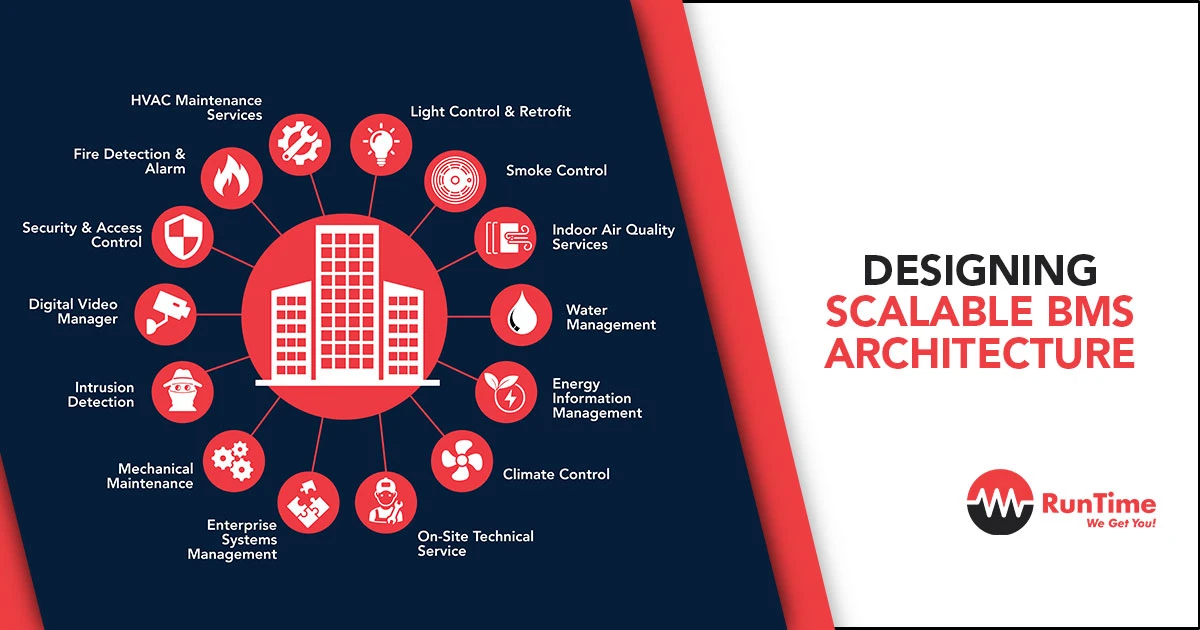It is crucial to have a building management system (BMS) with a scalable and flexible infrastructure. To create a scalable BMS architecture, it is essential to anticipate future growth, adapt to technological advancements, and seamlessly integrate new systems and devices. In this guide, we’ll explore the technical aspects of building a BMS architecture that meets current needs and is strong enough to accommodate future demands.
Understanding Scalability in BMS
Scalability in the context of BMS refers to the system’s ability to expand its capacity and functionalities without undergoing a complete overhaul. This encompasses not just the physical expansion in terms of more devices or sensors being added to the system but also the integration capabilities with other systems, data handling capacity, and the processing power to analyze and act on the data in real-time.
The Multi-layered Approach
A scalable BMS architecture typically adopts a multi-layered approach, comprising the field layer, control layer, management layer, and integration layer. Each layer is designed to serve specific functions, allowing for efficient data flow, processing, and management.
- Field Layer: This is the foundational layer where physical devices, sensors, and actuaries reside. Designing this layer with scalability in mind involves choosing devices that can be easily networked, support standard communication protocols, and are capable of firmware updates to adapt to future needs.
- Control Layer: Here, the controllers process data from the field devices and execute automation rules. Scalability at this layer means selecting controllers with sufficient processing power and memory, which can handle an increased load from more devices or more complex automation rules in the future.
- Management Layer: This layer involves software platforms that allow human operators to monitor, manage, and analyze building operations. A cloud-enabled scalable management layer supports modular software components and can integrate with various data analytics and AI tools for advanced operational insights.
- Integration Layer: Finally, the integration layer ensures that the BMS can communicate with other systems, such as HVAC, lighting, security, and even external systems like the electric grid or IoT platforms. Scalability here involves adopting open standards and APIs to facilitate seamless integration now and in the future.
Key Considerations for Scalable BMS Design
Adopting Open Standards and Protocols
One of the cornerstones of a scalable BMS architecture is the adoption of open standards and protocols. This approach ensures compatibility and interoperability among various systems and devices, making future expansions and integrations less cumbersome. Protocols like BACnet, Modbus, and LonWorks are widely recognized and offer the flexibility needed for scalable systems.
Modular and Microservices-based Architecture
Designing the BMS software stack as a collection of modular components or microservices significantly enhances its scalability. This architecture allows for individual services to be updated, replaced, or scaled independently without affecting the entire system. It also facilitates easier integration with new technologies and systems as they emerge.
Cloud Connectivity and Edge Computing
Leveraging cloud connectivity and edge computing can dramatically improve the scalability of a BMS. Cloud platforms offer virtually limitless storage and computing resources, enabling the BMS to scale as needed. Meanwhile, edge computing allows for data processing closer to the source, reducing latency and bandwidth requirements, and enabling real-time responses to critical events.
Data Management and Analytics
As buildings become more connected, the volume of data generated by BMS grows exponentially. A scalable BMS architecture must incorporate robust data management and analytics capabilities. This involves not just storing vast amounts of data but also analyzing it efficiently to extract actionable insights. Technologies such as AI and machine learning play a crucial role in this aspect, enabling predictive maintenance, energy optimization, and personalized occupant experiences.
Security and Privacy
Finally, a discussion on BMS scalability would only be complete with addressing security and privacy concerns. As systems expand and integrate with external networks, they become more vulnerable to cyber threats. A scalable BMS architecture must, therefore, incorporate strong security protocols, regular software updates, and data encryption to protect against unauthorized access and ensure data privacy.
Key Takeaways
Designing a scalable BMS architecture is a complex yet rewarding challenge. It requires a forward-looking approach, considering not just the current needs but also anticipating future demands. By focusing on modular design, adopting open standards, leveraging cloud and edge computing, incorporating robust data analytics, and prioritizing security, businesses can ensure their BMS is flexible, efficient, and prepared to adapt to the ever-changing technological landscape. The goal is to create a system that not only enhances operational efficiency and sustainability today but also remains relevant and effective in the years to come.
Hire Control Systems Engineers with RunTime
At RunTime, we are dedicated to helping you find the best Control Systems Engineering talent for your recruitment needs. Our team consists of engineers-turned-recruiters who have an extensive network and a focus on quality. By partnering with us, you will have access to great engineering talent that drives innovation and excellence in your projects.
Discover how RunTime has helped 423+ tech companies find highly qualified and talented engineers to enhance their team’s capabilities and achieve strategic goals.
On the other hand, if you’re a control systems engineer looking for new opportunities, RunTime Recruitment’s job site is the perfect place to find job vacancies.









